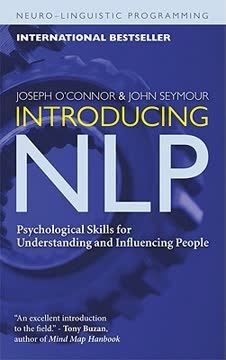Key Takeaways
1. NLP: The Art and Science of Personal Excellence
NLP is the art and science of excellence, derived from studying how top people in different fields obtain their outstanding results.
Defining NLP. Neuro-Linguistic Programming (NLP) is a powerful methodology for understanding and replicating human excellence. It's an "art" because each individual brings unique personality and style, and a "science" because it provides a systematic process, called modeling, to uncover the patterns of outstanding achievement. This approach offers practical skills for effective communication, personal development, and accelerated learning across various domains like counseling, education, and business.
Origins and Evolution. NLP began in the early 1970s with John Grinder and Richard Bandler at the University of California, Santa Cruz. They studied exceptional therapists like Fritz Perls, Virginia Satir, and Milton Erickson, not to create a new therapy, but to identify and teach the underlying patterns of their success. Gregory Bateson, a prominent anthropologist, significantly influenced their work, emphasizing systems theory and communication.
Core Components. The name "Neuro-Linguistic Programming" reflects its three foundational ideas:
- Neuro: All behavior originates from our neurological processes (sight, sound, touch, taste, smell).
- Linguistic: We use language to organize thoughts, behavior, and communicate with others.
- Programming: We can organize our ideas and actions to achieve desired results.
NLP focuses on the structure of subjective experience—how we filter the world, describe it, and act to produce outcomes.
2. Your Map is Not the Territory: Shaping Reality Through Perception
The world is always richer than the ideas we have about it.
Subjective Reality. We perceive the world through our senses, but this perception is heavily filtered by our unique experiences, culture, language, beliefs, values, and assumptions. Everyone lives in their own "unique reality," a personal "map" of the world, which is always a simplification of the vast, rich "territory" of objective reality. This map dictates how we make sense of information and, consequently, how we act.
Perceptual Filters. Our beliefs and interests act as powerful filters, causing us to notice some things while ignoring others. For example, an artist, a lumberjack, and a botanist walking through a wood will each perceive and focus on vastly different aspects. Narrow filters can lead to an impoverished, predictable world, while broader filters reveal richness and excitement. NLP encourages changing these filters to change one's world.
Behavioral Frames. NLP introduces useful "behavioral frames" to guide our thinking:
- Outcome vs. Problem: Focus on what you want, not what's wrong.
- How vs. Why: Understand the structure of a problem, not just justifications.
- Feedback vs. Failure: See results as learning opportunities, not dead ends.
- Possibilities vs. Necessities: Explore choices rather than constraints.
- Curiosity & Fascination vs. Assumptions: Embrace learning like a child, questioning what is "known."
3. Master Your State: Accessing Emotional Resources at Will
Imagine the impact on your life if you could switch on your high-performance states at will.
The Power of State. Our "state of mind" encompasses all our thoughts, emotions, and physiology at any given moment. Mind and body are deeply interconnected; thoughts influence physiology, and vice versa. We often feel our emotions are beyond control, but they are merely the visible tip of an iceberg, supported by underlying physiological and thought processes. Changing your state can dramatically alter your perception of the world.
Elicitation and Calibration. We can consciously influence our states. "Elicitation" is the process of guiding someone into a particular state, often by asking them to recall a past experience of that emotion. "Calibration" is the skill of recognizing when someone is in a different state by observing subtle nonverbal cues:
- Physiological changes: Breathing patterns, skin color, muscle tension, posture.
- Eye accessing cues: Specific eye movements linked to visual, auditory, or kinesthetic thinking.
Developing sensory acuity allows us to detect these subtle shifts, moving beyond relying solely on verbal communication.
Anchoring Resources. An "anchor" is any stimulus that triggers a physiological state. These can be natural (a song evoking a memory) or intentionally set. By linking a desired resourceful state (e.g., confidence) to a unique, repeatable stimulus (e.g., a specific touch, internal word, or image), you can "fire" that anchor to access the state at will. This allows for emotional freedom, enabling peak performance and transforming how you approach challenges.
4. Language: The Bridge to Understanding (and Misunderstanding)
Words are cheap, the saying goes, they cost nothing, yet they have power to evoke images, sounds and feelings in the listener or reader as every poet and advertising copywriter knows.
The Power of Words. Language is a powerful tool, capable of evoking vivid internal experiences and shaping our reality. However, words are inherently meaningless until we give them meaning through our unique, anchored associations to experiences. This means that while language facilitates communication, it also creates immense potential for misunderstanding, as no two people share identical maps of the world or the exact same meanings for abstract concepts like "love" or "respect."
Deep vs. Surface Structure. Our thoughts, the "deep structure," are rich and complex, a blend of mental pictures, sounds, and feelings. When we translate these into spoken words, the "surface structure," we unconsciously delete, distort, and generalize information to make communication concise. This simplification, while necessary for conversation, can obscure the original meaning and lead to misinterpretations.
The Meta Model. The Meta Model is an NLP tool designed to clarify imprecise language by asking specific questions that reconnect words to sensory experience and the deep structure. It helps to:
- Unspecified Nouns/Verbs: "Who/What specifically?" or "How specifically?" (e.g., "The child had an accident" -> "Which child? How did it happen?")
- Comparisons/Judgments: "Compared to what?" or "Who says?" (e.g., "This is better" -> "Better than what?")
- Nominalizations: Turn abstract nouns back into verbs to find missing information (e.g., "Education" -> "Who is educating whom, and how?")
- Modal Operators (Possibility/Necessity): "What would happen if you did/didn't?" (e.g., "I can't do it" -> "What stops you?")
- Universal Quantifiers: "Never?" or "Always?" (e.g., "I never do anything right" -> "Never?")
- Complex Equivalence: "How does this mean that?" (e.g., "You're not smiling, so you're unhappy" -> "How does not smiling mean unhappiness?")
- Cause and Effect: "How exactly do you make yourself feel that way?" (e.g., "You make me angry" -> "How do you make yourself angry at what I say?")
- Mind Reading: "How exactly do you know?" (e.g., "I know he's upset" -> "How do you know he's upset?")
Used with rapport, the Meta Model gathers high-quality information, clarifies meanings, and expands choices by challenging limiting linguistic patterns.
5. Harness the Unconscious Mind with Artful Communication
The Milton Model is a way of using language to induce and maintain trance in order to contact the hidden resources of our personality.
Uptime and Downtime. NLP distinguishes between "Uptime," a state of outward sensory awareness, and "Downtime," a state of inward focus on thoughts and feelings. While everyday consciousness is a blend, deep thought or trance involves significant downtime. Trance, a state of highly focused attention, bypasses the conscious mind to access unconscious resources, which is crucial for profound personal change.
The Milton Model. Developed from modeling Milton Erickson, the Milton Model is the inverse of the Meta Model. Instead of seeking precision, it uses artfully vague language to induce and maintain trance, allowing the listener to fill in meaning from their own unconscious resources. This approach respects the unconscious mind, assuming it holds all necessary resources and positive intentions.
Techniques of the Milton Model:
- Pacing and Leading: Describing the listener's current sensory experience (pacing) and then subtly introducing suggestions to guide them inward (leading).
- Distraction of Conscious Mind: Using deletions, distortions, generalizations, and ambiguities (phonological, syntactic, punctuation) to keep the conscious mind busy, allowing unconscious messages to pass through.
- Accessing Unconscious Resources: Embedding commands or questions within sentences, often marked by vocal tone or gesture, to directly communicate with the unconscious. Metaphors and stories are also powerful tools, as their indirect nature allows the unconscious to find relevant meanings and solutions.
The Milton Model leverages the brain's natural processing, particularly the right hemisphere's holistic and intuitive understanding, to facilitate inner-directed learning and change.
6. Reframe Your Reality: Transform Meaning and Gain Choice
What does a rainstorm mean? Bad news if you are out in the open without a raincoat. Good news if you are a farmer and there has been a drought.
Meaning is Context-Dependent. Events themselves are neutral; it's the "frame" we put around them that gives them meaning. Changing this frame transforms the meaning, which in turn changes our responses and behavior. Reframing is not about denying problems but about finding new perspectives that offer greater freedom and choice. Jokes, for instance, are classic reframes, suddenly shifting context or meaning.
Context Reframing. This involves asking, "When or where would this behavior be useful?" Nearly all behaviors, even seemingly negative ones, have a positive value or purpose in some context. For example, being indecisive might be useful if you're deciding whether to lose your temper. By identifying an appropriate context, you can re-evaluate the behavior and develop more fitting responses in the original problematic situation.
Content Reframing. This asks, "What else could this mean?" or "What is the positive value of this behavior?" It focuses on changing the interpretation of the content of an experience. For example, "I get angry when people make demands on me" could be reframed as "That anger shows you value your autonomy and need to set boundaries." This shifts the focus from the negative emotion to the underlying positive intention, opening up new ways to respond.
Intention vs. Behavior. At the core of reframing is distinguishing between what you do (behavior) and what you are trying to achieve (intention). Often, unwanted behaviors are attempts to fulfill a positive intention, albeit in an unhelpful way. Instead of trying to stop a behavior with willpower, NLP suggests finding new, more ecological ways to satisfy the underlying positive intention. This acknowledges that we are a collection of "parts," each with its own purpose, and aligning these intentions leads to greater congruence.
7. Navigate Time: Reshape Your Past and Design Your Future
Human experience only exists in the present moment. The past exists as memories and to remember these we have to re-experience them in some way in the present.
Subjective Time. While external time is measured by clocks, our internal experience of time is fluid and subjective. We have a "time machine" in our minds, allowing us to jump between past, present, and future. Our brains organize memories and future expectations in specific ways, often spatially, which influences how we perceive and react to events. For example, the past might be to our left, the future to our right, with submodalities like brightness or size indicating proximity or importance.
Timelines and Their Impact. The way we store our "timeline" affects our thinking and behavior:
- "Through Time" (Anglo-European): Past and future are spread out in front, visible, leading to a linear, sequential view of time, often associated with punctuality and dissociated memories.
- "In Time" (Arabic): The timeline stretches front-to-back, with parts (often the past) behind and invisible, leading to a focus on the present moment, more flexible timekeeping, and associated memories.
Understanding one's timeline helps explain different approaches to planning, deadlines, and even recovery from illness. Changing timeline submodalities (e.g., making future pictures brighter) can shift one's orientation and motivation.
Change Personal History. This technique re-evaluates troublesome memories by bringing new resources to past experiences. It involves:
- Identifying a recurring negative state and its earliest memory.
- Eliciting and anchoring a powerful resource state in the present.
- Taking the client back to the earliest memory, first double-dissociated (watching themselves watch the event), then associated, with the new resource.
This process changes the meaning of the past event, transforming it from a limitation into a learning experience, without altering what "actually happened."
Future Pacing. This is the final step in many NLP techniques, involving mentally rehearsing a desired outcome or new behavior in a future context. It tests the effectiveness of changes and primes the body and mind for success. By giving the brain strong, positive images of success, future pacing acts as a self-fulfilling prophecy, making desired outcomes more likely. It's a powerful form of mental preparation used by top performers in all fields.
8. Achieve Congruence: Aligning Your Inner Self for Outer Success
Internal congruence gives strength and personal power.
The Nature of Conflict. Conflict arises because we make different models of the world, leading to diverse values, beliefs, and interests. Internally, different "parts" of ourselves can also conflict, making it difficult to pursue an outcome wholeheartedly. Congruence means all our verbal and nonverbal behaviors, and all our internal parts, are aligned and working in harmony towards a shared outcome, providing strength and personal power.
Identifying Congruence and Incongruence.
- Congruence Signal: Recalling a time of intense desire or excitement helps identify the unique internal feeling, sight, or sound that signifies full commitment.
- Incongruence Signal: Remembering a time of doubt or reservation reveals subtle physical cues (e.g., a specific body feeling, facial expression, or voice tone) that indicate internal conflict.
Detecting these signals, both in oneself and others, provides invaluable information. Incongruence in others often manifests as mixed messages, while in oneself, it's a signal to gather more information or explore alternative outcomes.
Values and Criteria. Our values are fundamental principles that motivate us and define what's important. They are often unconscious and supported by beliefs. "Criteria" are context-specific values, the reasons we do something and what we get out of it (e.g., wealth, success, fun). Eliciting criteria involves asking "What's important to me?" and "How would I know if I got them?" Understanding the hierarchy of criteria helps align actions with deeper motivations.
Internal Conflict Resolution. When internal parts conflict, negotiation skills can be applied within oneself. This involves:
- Identifying Parts: Clearly separating conflicting internal "parts" (e.g., the part that wants leisure vs. the part that wants security).
- Finding Positive Intentions: Recognizing that each part has a positive intention, even if its behavior is unhelpful.
- Negotiating and Integrating: Facilitating communication between parts to find shared outcomes, trade resources, and cooperate. If willing, parts can be integrated, creating a new, unified sense of self that reviews the timeline with new understanding. This process resolves deep-seated conflicts, leading to greater balance and personal effectiveness.
9. Uncover Metaprograms: Understand How You (and Others) Process the World
Metaprograms are perceptual filters that we habitually act on.
Perceptual Filters. Metaprograms are systematic and habitual filters that determine what information we pay attention to and how we process it. They are unconscious patterns that shape our map of the world, influencing motivation, decision-making, and communication. While context-dependent, understanding metaprograms allows us to tailor communication to resonate with another person's internal processing style.
Key Metaprogram Patterns:
- Proactive-Reactive:
- Proactive: Initiates action, jumps in, motivated by "Go to it!"
- Reactive: Waits for others, analyzes, motivated by "Let's analyze."
- Towards-Away:
- Towards: Focused on goals, motivated by rewards ("What do I want?").
- Away: Focused on problems, motivated to avoid ("What do I want to avoid?").
- Internal-External:
- Internal: Uses own standards for decisions ("I just know").
- External: Needs external standards and direction ("Someone told me").
- Options-Procedures:
- Options: Seeks choices, develops alternatives, resists fixed paths.
- Procedures: Follows set courses of action, believes in "the right way."
- General-Specific:
- General: Sees the big picture, large chunks of information.
- Specific: Focuses on details, small chunks, sequences.
- Match-Mismatch:
- Match: Notices similarities, prefers gradual change.
- Mismatch: Notices differences, seeks change and innovation.
- Convincer Patterns:
- Channel: How information is received (Visual, Auditory, Read, Do).
- Mode: How many times or over what period information is needed to be convinced (Number of Examples, Automatic, Consistent, Period of Time).
Application. Identifying these patterns in oneself and others through language and behavior allows for more effective communication, better team building, and tailored motivational strategies. For example, a "towards" person responds to incentives, while an "away" person responds to avoiding problems. NLP emphasizes that no pattern is inherently "better"; usefulness depends on context and desired outcome.
10. Model Excellence: Replicate Success by Understanding Strategies, Beliefs, and Physiology
Modeling can be simply defined as the process of replicating human excellence.
The Core of NLP. Modeling is the foundational process of NLP, explicitly uncovering the behavioral patterns of successful individuals. It bypasses the idea of "inborn talent" by asking: "What do top performers do differently?" and "How can we replicate those results?" NLP models what is possible because real people have already achieved it.
Phases of Modeling:
- Immersion: Being with the model, imagining yourself in their reality (second position), and doing what they do to achieve similar results. Focus on:
- What: Observable behavior and physiology.
- How: Internal thinking strategies.
- Why: Supporting beliefs and assumptions.
- Refinement: Systematically removing elements of the model's behavior to identify what is essential and what makes a critical difference. This conscious analysis refines the model.
- Teaching: Designing a way to teach the acquired skill to others, creating an environment where students can learn to achieve the same results.
Components of Excellence: To model any human behavior, you need to understand three key elements:
- Beliefs: The guiding principles and assumptions that support or inhibit behavior. Eliciting beliefs (e.g., "Why do you do what you do?") and "trying them on" (acting "as if" they are true) can profoundly shift capabilities.
- Physiology: The physical state, posture, breathing, and movements associated with a particular skill or state. Replicating a model's physiology (e.g., a skier's body movements) can provide immediate access to their internal state and resources.
- Strategies: The specific sequence of internal and external representations (visual, auditory, kinesthetic) used to accomplish a task. Like a recipe, a strategy requires knowing the "ingredients" (representational systems), their "amounts and quality" (submodalities), and the "correct order of steps." Examples include spelling strategies (visualizing words) or creative strategies (like Walt Disney's Dreamer-Realist-Critic approach).
Accelerated Learning. Modeling is the basis of accelerated learning, moving directly to "unconscious competence" by first doing, then analyzing. It's a "bootstrap program" for personal development, allowing individuals to model their own resourceful states and continuously enhance their capabilities.
11. NLP's Core Purpose: Increase Choice, Wisdom, and Accelerated Learning
The purpose of NLP is to be useful, to increase choice, and to enhance the quality of life.
Beyond Techniques. While NLP offers a powerful toolkit of techniques, its deeper purpose lies in fostering wisdom, balance, and increased choice. It's a "meta-discipline," a systematic approach to "learning to learn," providing a framework for understanding how we construct our subjective experience and how we can consciously shape it. This is crucial in a world where knowledge is accelerating, but wisdom often lags.
The Ecology of Mind. NLP emphasizes the "ecology of mind," recognizing that individuals are part of larger systems (family, work, society). Changes must be congruent with one's overall integrity and respect the integrity of others. This systemic thinking, influenced by Gregory Bateson, highlights that small, well-placed changes can have profound, positive ripple effects throughout a system, much like the "Butterfly Effect."
Individual and Societal Change. NLP posits that social change begins with individual change. By exploring and transforming our inner reality—our beliefs, strategies, and states—we can more wisely influence and shape the external world. It encourages a shift from viewing nature and ourselves as machines to seeing them as dynamic, interconnected organisms.
A New Paradigm. NLP represents a "next generation of psychology," moving beyond objective analysis to embrace subjective experience. It's about becoming aware of how we make our models of reality, rather than confusing those models with reality itself. Ultimately, NLP aims to empower individuals to live more effectively, gracefully, and wisely, fostering a continuous process of self-discovery and the creation of a better world.
Last updated:
Review Summary
Introducing NLP receives mixed reviews, with an average rating of 3.75/5. Many readers find it a helpful introduction to NLP concepts and techniques, praising its clear explanations and practical applications. Some appreciate its potential for personal growth and improved communication. However, critics argue it's outdated, lacks depth, and oversells NLP's effectiveness. Several reviewers note the book's dry, textbook-like style, while others find it engaging. Overall, it's recommended for those new to NLP but may not satisfy more advanced readers or skeptics.
Similar Books










Download PDF
Download EPUB
.epub digital book format is ideal for reading ebooks on phones, tablets, and e-readers.





